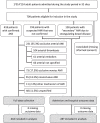Incidence, diagnosis, management and outcome of acute mesenteric ischaemia: a prospective, multicentre observational study (AMESI Study)
- PMID: 38263058
- PMCID: PMC10807222
- DOI: 10.1186/s13054-024-04807-4
Incidence, diagnosis, management and outcome of acute mesenteric ischaemia: a prospective, multicentre observational study (AMESI Study)
Abstract
Background: The aim of this multicentre prospective observational study was to identify the incidence, patient characteristics, diagnostic pathway, management and outcome of acute mesenteric ischaemia (AMI).
Methods: All adult patients with clinical suspicion of AMI admitted or transferred to 32 participating hospitals from 06.06.2022 to 05.04.2023 were included. Participants who were subsequently shown not to have AMI or had localized intestinal gangrene due to strangulating bowel obstruction had only baseline and outcome data collected.
Results: AMI occurred in 0.038% of adult admissions in participating acute care hospitals worldwide. From a total of 705 included patients, 418 patients had confirmed AMI. In 69% AMI was the primary reason for admission, while in 31% AMI occurred after having been admitted with another diagnosis. Median time from onset of symptoms to hospital admission in patients admitted due to AMI was 24 h (interquartile range 9-48h) and time from admission to diagnosis was 6h (1-12 h). Occlusive arterial AMI was diagnosed in 231 (55.3%), venous in 73 (17.5%), non-occlusive (NOMI) in 55 (13.2%), other type in 11 (2.6%) and the subtype could not be classified in 48 (11.5%) patients. Surgery was the initial management in 242 (58%) patients, of which 59 (24.4%) underwent revascularization. Endovascular revascularization alone was carried out in 54 (13%), conservative treatment in 76 (18%) and palliative care in 46 (11%) patients. From patients with occlusive arterial AMI, revascularization was undertaken in 104 (45%), with 40 (38%) of them in one site admitting selected patients. Overall in-hospital and 90-day mortality of AMI was 49% and 53.3%, respectively, and among subtypes was lowest for venous AMI (13.7% and 16.4%) and highest for NOMI (72.7% and 74.5%). There was a high variability between participating sites for most variables studied.
Conclusions: The overall incidence of AMI and AMI subtypes varies worldwide, and case ascertainment is challenging. Pre-hospital delay in presentation was greater than delays after arriving at hospital. Surgery without revascularization was the most common management approach. Nearly half of the patients with AMI died during their index hospitalization. Together, these findings suggest a need for greater awareness of AMI, and better guidance in diagnosis and management.
Trial registration: NCT05218863 (registered 19.01.2022).
Keywords: Diagnosis; Epidemiology; Management; Mesenteric ischaemia; Outcome.
© 2024. The Author(s).
Conflict of interest statement
ARB has received speaker or consultancy fees from Nestlé, VIPUN Medical, Nutricia and Fresenius Kabi, and is holding a grant from Estonian Research Council (PRG1255). AF has received speaker fees from B Braun and Fresenius Kabi. AN has received speaker or consultancy fees from Abbvie and Janssen, research funding from MSD-Avenir, and PhD grants from Fondation de l’Avenir and SNFGE. SA, MBa, MBj, ZB, DC, MD, ZD, VDMC, HF, MH, BH, KK, MK, KL, ML, CIL, DJM, MMu, MMä, SS, MS, JS, PT, ALV, KV, MAY and KT declare no conflicts of interest. All authors completed the ICMJE uniform conflict of interest disclosure form.
Figures
Comment in
-
The acute mesenteric ischaemia (AMESI) study: a matter of incidence.Crit Care. 2024 Mar 4;28(1):67. doi: 10.1186/s13054-024-04850-1. Crit Care. 2024. PMID: 38438848 Free PMC article. No abstract available.
-
The incidences of acute mesenteric ischaemia vary greatly depending on the population and diagnostic activity.Crit Care. 2024 Mar 18;28(1):85. doi: 10.1186/s13054-024-04870-x. Crit Care. 2024. PMID: 38500182 Free PMC article. No abstract available.
References
Publication types
MeSH terms
Associated data
Grants and funding
LinkOut - more resources
Full Text Sources
Medical




